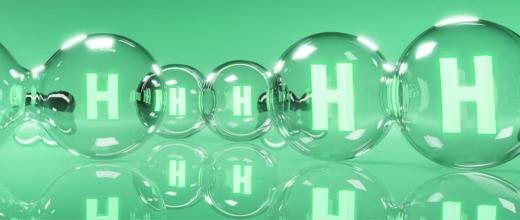01.02.2024
5 minutes of reading
Long neglected, natural hydrogen is now the focus of keen interest. Although significant advances have been made in terms of understanding its origin and its formation mechanisms, available reserves and production methods remain largely uncertain, requiring further research and development to fully evaluate its potential in the global energy transition.
Here we review the current state of knowledge with Yannick Peysson, manager of IFPEN’s “Sustainable uses of the subsurface for the energy transition” research program.
When was natural hydrogen first discovered?
The presence of hydrogen in the subsurface environment was first observed a long time ago. In France, for example, gases containing more than 6% hydrogen were observed in a small - now depleted - gas field discovered in 1906 at a site in Ambérieu en Bugey, in the Ain region. Globally, the presence of hydrogen was also detected while drilling the Kola superdeep borehole, the world’s deepest man-made hole, located in the Russian part of the Scandinavian peninsula. Since these discoveries, a number of research studies have confirmed the presence of hydrogen at different sites. However, it was the commissioning of the Bourakebougou well in Mali in 2013 that marked a milestone in the growing awareness of the potential of natural hydrogen. In 2008, IFPEN’s researchers began studying hydrogen seeps at various locations on the earth’s surface in order to evaluate the resource’s potential. This research demonstrated that hydrogen was observed in several types of geological environments.
Where are these natural hydrogen “sources” located?
H2 emission is a widespread phenomenon in the major peridotite areas. Peridotite is the dominant rock in the Earth’s mantle, where H2 concentrations can exceed 80%. This gas is systematically associated with nitrogen and methane, and in some areas with relatively high concentrations of helium. Associated geographic zones are located where tectonic plates meet: Oman, New Caledonia, the Philippines, Turkey, etc.
H2 seeps are also present in numerous zones associated with geological structures in the middle of continents. This is the case in Kansas and Mali, sites studied by IFPEN, but also other aeras in South America, Africa, Australia. In China too, H2 was discovered in the deep part of the Songliao basin in 2022. These seeps seem to originate in very old, iron-rich rocks.
Volcanic gases also frequently contain variable quantities of H2. In Iceland, for example, relatively high concentrations of H2 have been found during geothermal drilling operations. The same is true in Italy, in the Lardarello region, and along the East-African rift.
What are the hypotheses in terms of the origins of natural hydrogen?
The gradual accumulation of knowledge increasingly points out that natural H2 has its source in the very deep underground environment.Various formation mechanisms have been suggested, particularly the natural oxidation of Iron-rich rocks by water. The proximity of basic rocks and the presence of significant gravimetric and magnetic anomalies are common, also pointing to an H2 origin associated with the presence of iron-rich rocks.
Other reactions also play a role in volcanic systems and can provide production mechanisms, such as sulfur oxidation reactions in hydrothermal systems. In some zones with high concentrations of radioactive elements, water radiolysis is frequently suggested by various authors as a formation process.
The thermal cracking of hydrocarbons may also be responsible for H2 genesis in deep basins. Lastly, microbial activity is also a cause of H2 genesis under certain conditions.
What research is currently being conducted at IFPEN?
The research currently underway is aimed at acquiring knowledge concerning origin, formation mechanisms and consumption during migration to the surface, and at developing geological exploration tools in order to be able to provide industrial players with methods and software for quantifying potential reserves/resources.
Points to remember
• The existence of geological hydrogen is well documented and different production mechanisms are proposed providing an understanding of how hydrogen could be observed at different locations around the world and why increasingly high concentrations of H2 are detected during various drilling operations.
• However, considerable uncertainty remains in terms of available resources and potential reserves. The existence of reservoir rocks where the resource can accumulate and cap rocks where it can be trapped, has only been demonstrated in a few cases. The proportion of H2 consumed by mineral or biological subsurface reactions also remains a mystery.
• “Hydrogen systems” appear to benefit from very active production kinetics, so naturel hydrogen deep flow rates have to be considered as much as accumulation. . The potential for natural hydrogen production may prove considerable since, given sufficient accumulation or flows, the exploitation of this hydrogen through drilling and minimal surface treatment (gas separation, purification) could be achieved at costs well below those of other hydrogen production sources. It is this potential that continues to drive exploration activities and the active involvement of several industrial players within this exploration.
• The transition from the exploration phase to the early pilot phase and subsequent industrial-scale phase will take time and large-scale natural hydrogen production for the global market is unlikely to be seen much before the period 2035-2040. Appropriate research funding is thus required and needs to be stepped up in order to better understand the resource and estimate reserves and production conditions.








